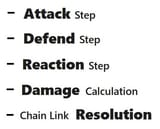Search Results
6/23/2025, 5:57:46 AM
>>95932258
Think of each turn of the game as a series of moments between the two characters. On your opponent's turn they try to attack you to force blocks or to concede loss of health, which is what the enemy needs to do to finish you. If you block with cards from hand you get fewer moments of opportunity to do stuff on your turn. This is the eb and flow of the game, like a dance between two performers, banking resources and lobbing assaults at each other while throwing up barricades to slow down progress.
An attack action card isn't always a singular move your hero takes, alternatively it could be a friend or an asset of the hero showing up at a pivotal moment to help. More commonly you see heroes taking swings at each other with their weapons, but consider action cards as persons, places and things that are at the disposal of your hero
Now with that basic introduction out of the way, what are the different styles and approaches these classes, talents and specifically unique heroes bring to the fight? Fast and deadly characters like Ninjas prefer to weave a flurry of weapons and attack actions together while strong and domineering ones such as Guardians send one decisive blow at the enemy; both are trying to overwhelm, but they go about it in different ways. When you hear people say "going wide" or "going tall" that is what they mean.
The combat chain sees cards added in a series of moments, sometimes starting with a spark and ending in a powder-keg towards the end. The wider your attacks can utilize 'go-again,' the more and more cards the enemy will have to commit to each chain link in order to stop you from damaging them. Now the tall swinger is seeking to pump up a singular damage source and limit the ability to defend with keywords like Dominate, which prohibit more than one card being sent to block from the enemy's hand. If you make an attack strong enough you tower over their defense.
'Board' means allies, auras, items & the like; all tangible advantages.
Think of each turn of the game as a series of moments between the two characters. On your opponent's turn they try to attack you to force blocks or to concede loss of health, which is what the enemy needs to do to finish you. If you block with cards from hand you get fewer moments of opportunity to do stuff on your turn. This is the eb and flow of the game, like a dance between two performers, banking resources and lobbing assaults at each other while throwing up barricades to slow down progress.
An attack action card isn't always a singular move your hero takes, alternatively it could be a friend or an asset of the hero showing up at a pivotal moment to help. More commonly you see heroes taking swings at each other with their weapons, but consider action cards as persons, places and things that are at the disposal of your hero
Now with that basic introduction out of the way, what are the different styles and approaches these classes, talents and specifically unique heroes bring to the fight? Fast and deadly characters like Ninjas prefer to weave a flurry of weapons and attack actions together while strong and domineering ones such as Guardians send one decisive blow at the enemy; both are trying to overwhelm, but they go about it in different ways. When you hear people say "going wide" or "going tall" that is what they mean.
The combat chain sees cards added in a series of moments, sometimes starting with a spark and ending in a powder-keg towards the end. The wider your attacks can utilize 'go-again,' the more and more cards the enemy will have to commit to each chain link in order to stop you from damaging them. Now the tall swinger is seeking to pump up a singular damage source and limit the ability to defend with keywords like Dominate, which prohibit more than one card being sent to block from the enemy's hand. If you make an attack strong enough you tower over their defense.
'Board' means allies, auras, items & the like; all tangible advantages.
Page 1
